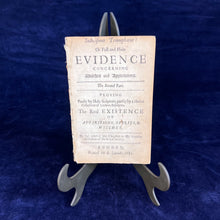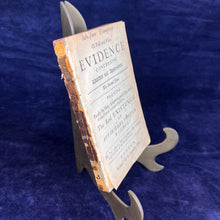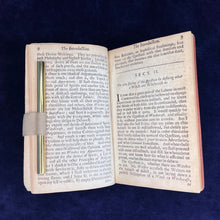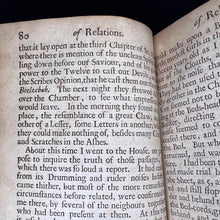GLANVIL[L], Joseph. Saducismus Triumphatus: Or Full and Plain Evidence Concerning Witches and Apparitions. The Second Part. Proving Partly by Holy Scripture, partly by a choice Collection of Modern Relations, The Real Existence of Apparitions, Spirits & Witches. London: Printed of S. Lownds, 1681. [1682]
SECOND EDITION. (175 x 110 mm) pp. [10] 1-273. Signatures: Aa - Ee8, Ff7 (lacks Ff1), Gg- Qq8, Rr6 (lacks Rr7, Rr8), Ss7. Apparently originally bound together with Parts I & III (spine label reads ‘uci’/ ‘mph’), likely part of a numbered collection (spine label ‘3’). Red Armenian bole on fore-edges. Lacking cover boards. Lacks frontispiece and p. 69, 257, 259. P. 263 slightly damaged. Overall FAIR condition.
Likely ESTC R2414 (variant); possibly ESTC R233939 (Matches holdings at Trinity College, Cambridge, Grylls 1.279)
Infamously influential, Saducismus Triumphatus, written by Joseph Glanvill (the sometime chaplain in ordinary to Charles II and philosopher) and published originally one year posthumously in 1681, uses an almost scientific approach of credited witnesses to his own investigations of the supernatural. Glanvill attempted to refute atheism and materialism by proving the existence and influence of witches, spirits, and demons. What he did was frenzy a society already prone to seeing, blaming, and trying people who they suspected to be in league with the Devil.
Glanvill’s work spread east and west, stoking the fires already burning on the Continent and lighting new ones in the Colonies of America, where the Puritan minister Cotton Mather forged his own text and his own trials based on Glanvill’s. Mather’s Wonders of the Invisible World (1693) defends the 1692-1693 Salem Witch Trials.
The three parts of the book were issued separately and often bound together by the owner. Many copies that have come to the market display three distinct cracks along the spine where the work has been disbound. Here, we have book two, the evidence through a collection of witnessed examples, which has been historically disbound.
The first edition, printed in 1681 for J. Collins at his shop under the Temple-Church, and S. Lownds and his shop, gave way to two (possibly three) second editions, printed a year later in 1682, also by S. Lownds. The title page for the Second Book, as in the present example, contains a misprinting, giving the year of printing as 1681.
The text was not printed again until 1688.
As the role of the government, rather than the role of the supernatural, has been identified as the culprit for the unjust deaths of people—85% of which were women—accused of witchcraft, Parliament is keen to show how its “role in religion has changed over the centuries.” The Witchcraft Act of 1542 mandated that “a perceived facility to summon evil spirits and demons to do harm to others” (the legal definition of witchcraft) was punishable by death. This act was repealed but restored by 1562. King James I, who believed his new Queen was under attack by witches rather than inclement weather on her ship’s crossing, fomented the interest in the malicious supernatural and published his own work, Daemonology, on the matter. During this time, the trying of witches passed from Church courts, into ordinary, secular courts.
Although last witchcraft trials were held in 1717 and capital punishment was repealed in 1738, the legal status and the ability to persecute supposed witches continued in England until 1951. Until this, the middle of the 20th century, a law supported fines and imprisonment for any who claimed to (or were accused of) using magical powers. This law was replaced by the Fraudulent Mediums Act. As of 2008, this law has also been repealed.
MB268








